One of the world’s historic sites is Agra Fort, built by Emperor Akbar, showcasing the Mughal architectural style. This is among the greatest examples of both architectural inventiveness and historical significance. The Mughals mostly employed red sandstone structures, which had a distinct surface finish, for residential reasons. Being close to the Yamuna River gives it an edge over appearing more ferocious than it is. Historically, it is important for its somewhat complicated architecture, extraordinarily high walls, and spectacular gates.
Location
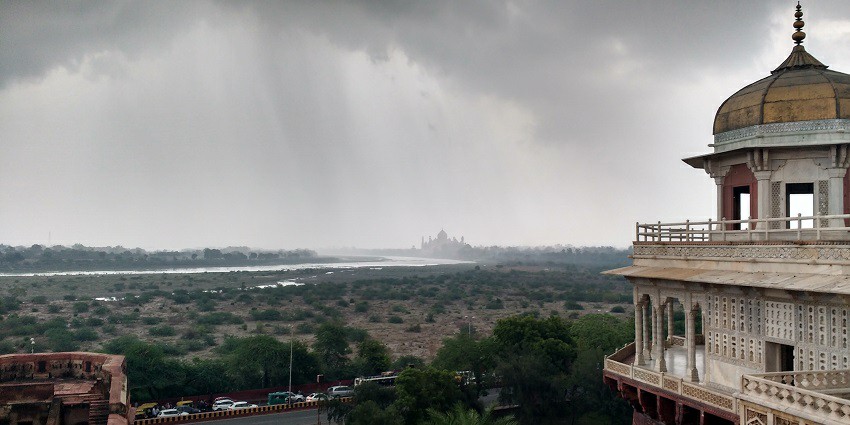
Photo: Akshatha Inamdar / Wikimedia Commons
On the right or western side of the Yamuna River, Agra fort is around 2.1 kilometres from the Taj Mahal and 2.5 km northeast of Agra city. It is located in central Agra, Uttar Pradesh, India. Reached by train, road, autorickshaw, tongas from the railway station, and various bus stops, the fort is situated in the heart of the town. History claims that due to the fort’s advantageous location, the Mughal Empire employed it for military purposes.
Suggested Read: Exploring Places To Visit Near Gorakhpur
How To Reach Agra Fort
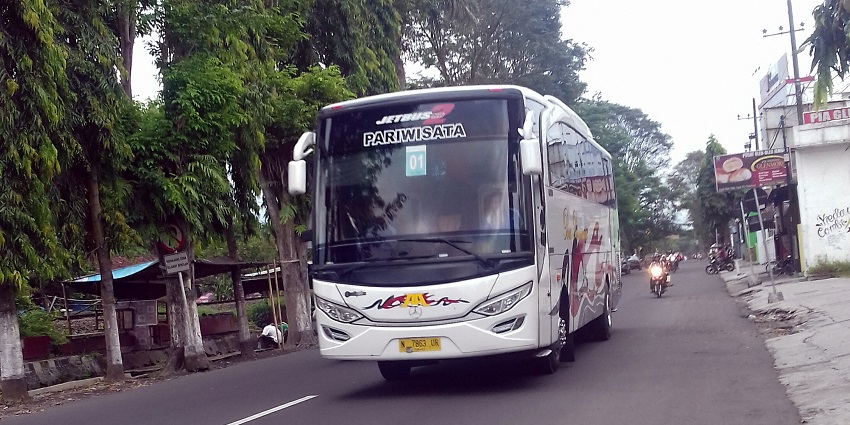
Photo: Ardhan Febriansyah / Wikimedia Commons / Image For Representation Only
You can easily reach Agra Fort:
By Road: Agra is well connected by the Yamuna Expressway and national highways, so getting to the fort was very easy. Those in or around the area of the Taj Mahal or the central business district of Agra can easily access the fort area on foot.
By Rail: The two nearest railway stations to Agra are Agra Cantonment and Agra Fort Railway Station. The road to the fort is sound and one can even drive down to Agra.
By Air: Kheria airport or Agra Fort is 13 km from the city and regularly offers private services and some domestic airlines.
Places To Visit In And Around Agra Fort
1. Taj Mahal

Photo: Yann / Wikimedia Commons
Taj Mahal, approximately 2.5 kilometres from the Agra Fort, is one of the seven wonders of the world. The Mughal Emperor Shah Jahan first constructed this structure out of white marble as a loving remembrance of his adored bride, Mumtaz Mahal. The focal point of the Izmailovo Gamma complex under study is renowned for its precisely proportioned and balanced centre structure. It changes throughout the day and is used to embellish numerous dawn and sunset-related movies and photographs. Even yet, it is still one of the most widely recognized representations of love.
Timings: 6 AM – 6:30 PM
Entry Fees: ₹50 for Indians and ₹ 1,100 for foreigners
Suggested Read: Top Places To Visit In Moradabad For Your Next Trip
2. Jama Masjid
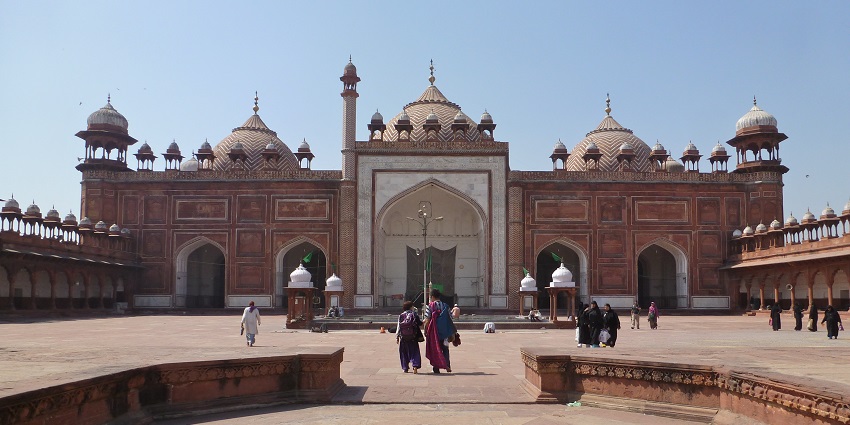
Photo: Jonathan Freundlich / Wikimedia Commons
Jama Masjid, a mere 1.5 kilometres from Agra Fort, is one of the largest mosques in India. It shows fine pieces of artwork of Mughal structure. Constructed in 1648 by the Mughal Emperor Shah Jahan in honour of his daughter Jahanara Begum, this utterly striking mosque is the largest. It has a sprawling courtyard and beautiful intricately carved prayer chamber. People find it quite serene and spend time there watching the great Mughal architecture.
Timings: Open from sunrise to sunset
Entry Fees: Free
3. Mehtab Bagh
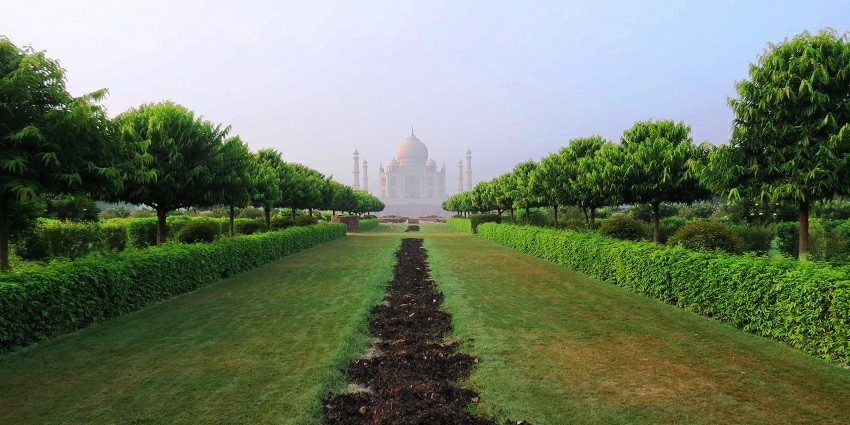
Photo: g.kaustav / Wikimedia Commons
This exotic, river-front garden known as Mehtab Bagh is just four kilometres from the Agra Fort. One of the most spectacular of these structures was earlier constructed by Emperor Babur within the moonlight garden i.e., Mehtab Bagh. This is shaped by the symmetry of laying. The two fountains and grassy lawns make it a perfect place for a photo shoot or just to spend some time resting. For those interested in intriguing Mughal landscaping, it is a place of no noise except the sobs of the river.
Timings: 6 AM – 7 PM
Entry Fees: ₹30 for Indians and ₹200 for the foreigners
Suggested Read: Things To Do In Greater Noida For An Unforgettable Experience
4. Itimad-Ud-Daulah’s Tomb
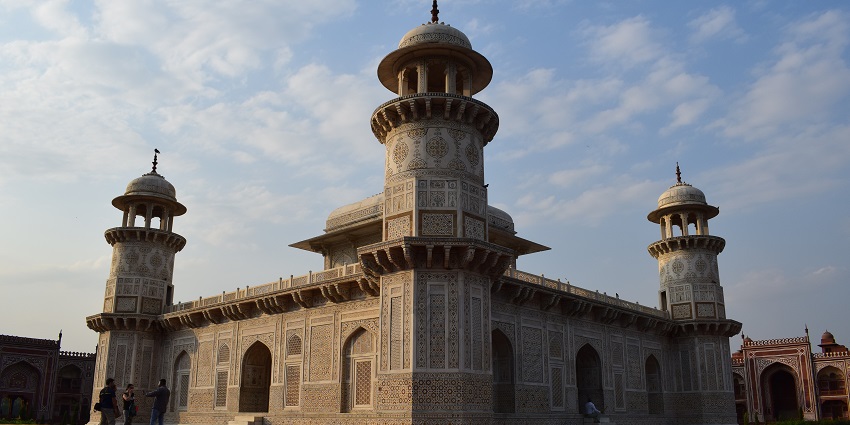
Photo: Mr. Debapriya Hore / Wikimedia Commons
Itimad-ud-Daulah’s Tomb is also called the Baby Taj. The monument is part of the Mughal architectural style. Conceived by Empress Nur Jahan for her father, it shows an elaborate sense of white marble work, screens of jali work, and Persian as well as Indian styles of architecture. It was the first Mughal structure built completely of white marble, a clear break from the past practice of architecture at Agra. It attracts visitors due to intricate work done on it and its location close to the Yamuna River.
Timings: 6 AM – 6 PM
Entry Fees: ₹25 for Indians and ₹310 for foreigners
5. Fatehpur Sikri
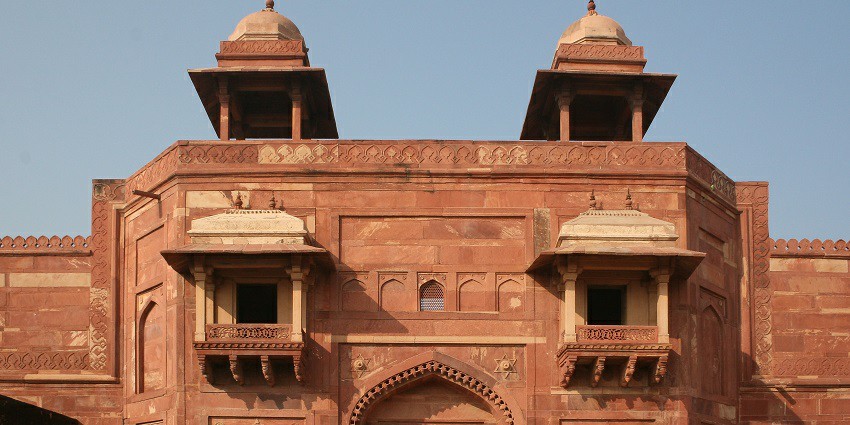
Photo: Diego Delso / Wikimedia Commons
Fatehpur Sikri, recognized as a world heritage site, stands with architectural grandeur. It is located 40 kilometres from Agra Fort and used to be the capital of the Mughal Empire. The city is also famous for its majestic palaces, mosques, and courtyards such as Buland Darwaza and Jama Masjid. It possesses all the famed and definitive flavours of Mughal planning and architectural ability. Though it was left barren due to lack of water, it still well illustrates the remaining historical entrance that was developed in the Mughal period.
Timings: 6 AM – 6 PM
Entry Fees: ₹60 for Indians including children while ₹ 610 for foreign tourists including children
Suggested Read: Places To Visit Near Ghaziabad For A Weekend Retreat
Where To Stay
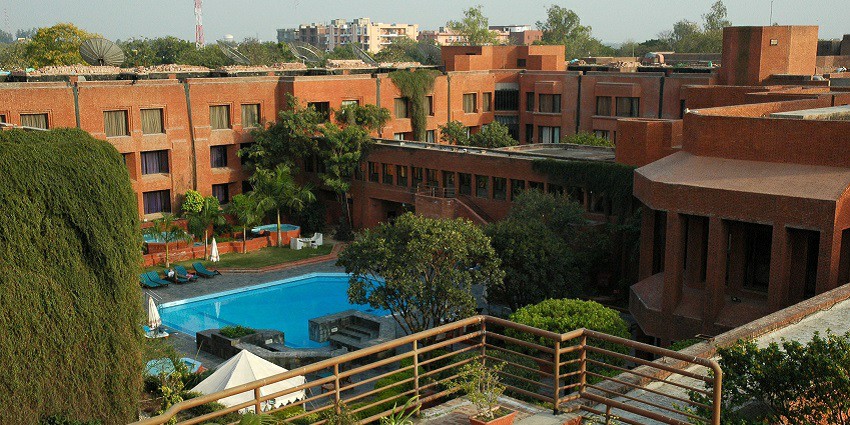
Photo: MGA73bot2 / Wikimedia Commons / Image For Representation Only
There are many hotels available in Agra near Agra Fort starting from cheap hotels to lavish hotels available for tourists. Some of the famous places that tourists prefer are The Oberoi Amarvilas having direct views of the Taj Mahal. You can also stay in Hotel Taj Resorts, just a sneak away from the Taj Mahal as well as Agra Fort. For the low-cost effective travellers, hostel, and backpacker hostels provide reasonable and cosy accommodations. In the case of luxuries, better accommodation or commercial importance, Agra has something waiting for any kind of visitor.
Where To Eat

Photo: Chait Goli / Pexels / Image For Representation Only
The food of Agra is mostly Mughlai and one is lucky to find many restaurants nearby to Agra Fort. B/fast at ITC Mughal provides authentic Mughlai food which is most popular in Peshawari and Pinch of spice, also the finest north Indian food. Esphahan at The Oberoi Amarvilas helps you enjoy traditional dishes with a contrasting view of the Taj Mahal for a totally exotic dining experience. People should try street food, including the petha sweets and the chaats available at Sadar Bazaar near this fort.
Suggested Read: Places To Visit In Fatehpur Sikri
Other Factors To Consider

Photo: Torsten Dettlaff / Pexels / Image For Representation Only
Agra fort is most suitably visited during the winter season which prevails from October to March.
Average Cost Of The Trip: On average, people spend ₹1,000 to ₹3,000 per person visiting Agra Fort including entry charges, meals as well as transport charges.
Tips For Travellers:
- Take water, wear good shoes, and plan to arrive early to avoid many people.
- One may also consider an employee guide for further explanations of how the fort was built and designed.
- Take some time and visit the neighbouring shops and markets to buy souvenirs and local artefacts.
The bundles of structures in the Agra Fort, based in the heart of India, narrate the history of the royal Mughals much beyond the fort. Agra fort satisfies every traveller with true spirit. You can get all the required details about Agra Fort here. You need to get these handy if you are planning to visit this incredible landmark. Now that you are well informed about all these features and requirements of Agra Fort, let TripXL create a travel package for you to enjoy the visit!
Cover Photo: Jakubhal / Wikimedia Commons / Image For Representation Only


 WhatsApp
WhatsApp
 Twitter
Twitter









